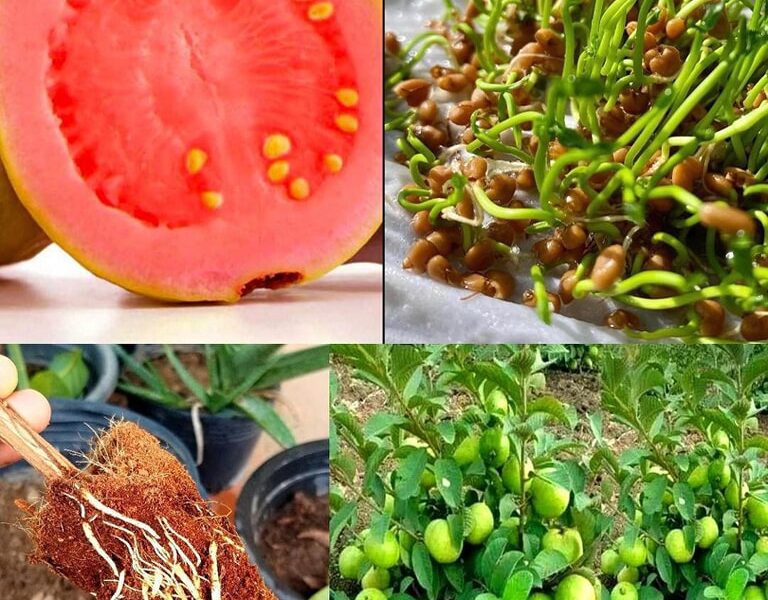Growing guava at home in pots: the secret to an abundant harvest
Guava (Psidium guajava) is a tropical delicacy that brings an explosion of sweet and aromatic flavor to the palate. While it typically thrives in tropical and subtropical regions, guava can be grown successfully at home in pots, allowing people from various climates to savor their own local harvest. In this complete guide, we will walk you through the entire process of growing guava at home in pots, from collecting seeds to caring for your potted guava tree to produce a bountiful harvest.
Guava seed harvest
The journey to homegrown guava begins with the acquisition of guava seeds. Here’s how to harvest seeds from a ripe guava:
Materials you will need:
- ripe guava fruit
- Knife
- Spoon
Step 1: Choose a ripe guava
- Select a ripe, ripe guava. It should yield slightly to gentle pressure, indicating it is ready for seed extraction.
Step 2: open the guava
- Using a clean, sharp knife, cut the guava in half. Be careful to avoid damaging the seeds.
Step 3: Remove the seeds
- Using a spoon, gently scoop out the seeds from the center of the guava. Occasionally, it is possible to find seeds embedded in the pulp; Make sure you collect them all.
Step 4: Clean the seeds
- Rinse the collected seeds under running water to remove any remaining fruit pulp, then dry them with a clean paper towel.

Germinate guava seeds
With the guava seeds in hand, you are ready to prepare them for planting. Proper germination sets the stage for healthy guava plants.
Materials you will need:
- Guava seeds
- wet paper towel
- Resealable plastic bag
Step 1: Prepare the Paper Towel
- Place the guava seeds on a damp paper towel. It should be moist but not too moist, and make sure the seeds are spaced out.
Step 2: Fold the Paper Towel
- Fold the paper towel over the seeds, creating a seed packet.
Step 3: Seal in a Ziplock Bag
- Place the folded paper towel with the seeds inside a zip-top plastic bag and seal it. This creates a controlled environment for germination.
Step 4: Store in a warm place
- Place the sealed ziplock bag in a warm, well-lit area, such as a windowsill or near a heat source. Guava seeds typically germinate best in temperatures between 75°F and 85°F (24°C and 29°C).
Step 5: Monitor and Wait
- Check the seeds regularly to maintain the paper towel’s moisture. Germination can take between 2 and 8 weeks, so patience is essential.

Planting guava seedlings in pots
- Once the guava seeds have sprouted and developed a small root, they are ready to transplant into pots.
Materials you will need:
- Guava seedlings
- potting mix
- Pots with drainage holes
- Watering can
- Balanced Slow Release Fertilizer
Step 1: prepare the pots
- Choose pots that are at least 10 to 12 inches in diameter and have good drainage holes to prevent waterlogging. Fill them with a well-draining potting mix suitable for fruit trees.
Step 2: Transplant seedlings
- Create a small hole in the center of the potting mix and gently place the sprouted guava seedling with the root pointing down into the hole. Carefully cover the seedling with soil.
Step 3: watering
- Water newly transplanted seedlings well and maintain constant humidity. Guavas appreciate a slightly humid environment, so avoid overwatering.
Step 4: Fertilization
- Once your guava seedlings are established, begin applying a balanced, slow-release fertilizer to provide the essential nutrients they need.

Caring for Your Potted Guava Tree
To ensure the success of your potted guava tree, proper care and attention is necessary:
- 1. Sunlight: Guava trees thrive in full sun, so place your pots in a location that receives at least 6 to 8 hours of direct sunlight per day.
- 2. Watering: Constantly water your guava tree to maintain uniform humidity. Make sure the soil remains constantly moist but not waterlogged.
- 3. Pruning: Regularly prune your guava tree to maintain its shape, remove dead or diseased branches, and encourage new growth.
- 4. Pests and diseases: Keep an eye out for common guava pests such as fruit flies and aphids. If necessary, apply appropriate treatments.
- 5. Frost Protection: If you reside in a cooler climate, provide your guava with frost protection during the winter months. Move the pots indoors or use a frosted cloth to protect the tree from freezing temperatures.
- 6. Fruit thinning: Thin out excess fruits while they are still small to ensure that the remaining fruits grow larger and healthier.
- 7. Harvest: Guavas are generally ready to harvest when they yield slightly to gentle pressure. Simply twist the fruit gently to detach it from the tree.

Growing guava at home in pots is a rewarding endeavor that can produce delicious fruit, regardless of the weather. With proper care, your potted guava tree will flourish and provide you with a bountiful harvest for years to come. Enjoy the sweet, tropical flavors of your own homegrown guavas!
